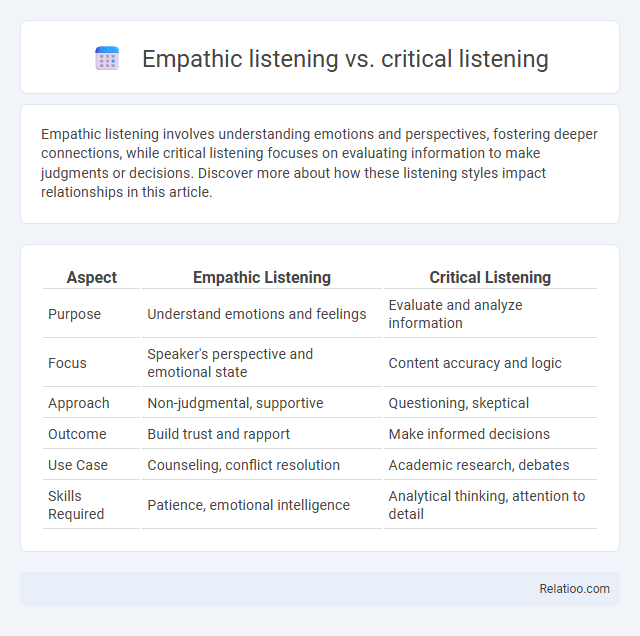Empathic listening involves understanding emotions and perspectives, fostering deeper connections, while critical listening focuses on evaluating information to make judgments or decisions. Discover more about how these listening styles impact relationships in this article.
Table of Comparison
| Aspect | Empathic Listening | Critical Listening |
|---|---|---|
| Purpose | Understand emotions and feelings | Evaluate and analyze information |
| Focus | Speaker's perspective and emotional state | Content accuracy and logic |
| Approach | Non-judgmental, supportive | Questioning, skeptical |
| Outcome | Build trust and rapport | Make informed decisions |
| Use Case | Counseling, conflict resolution | Academic research, debates |
| Skills Required | Patience, emotional intelligence | Analytical thinking, attention to detail |
Understanding Empathic Listening
Empathic listening focuses on deeply understanding and sharing the speaker's emotions, creating a connection that fosters trust and openness. Unlike critical listening, which evaluates and judges the content, empathic listening prioritizes emotional cues and nonverbal signals to grasp the speaker's true feelings. Your ability to engage in empathic listening enhances communication by validating the speaker's experience and promoting a supportive environment.
Defining Critical Listening
Critical listening involves analyzing and evaluating the message's content to determine its validity, logic, and relevance. Unlike empathic listening, which prioritizes understanding emotions and perspectives, critical listening requires you to focus on identifying arguments, biases, and evidence presented. Mastering critical listening enhances your ability to make informed decisions and respond thoughtfully in discussions.
Core Differences Between Empathic and Critical Listening
Empathic listening centers on understanding and sharing the speaker's emotions, fostering connection and trust by prioritizing feelings and personal experience. Critical listening involves evaluating, analyzing, and judging the content to form a reasoned opinion or decision, emphasizing accuracy and logic over emotional context. The core difference lies in empathic listening focusing on emotional resonance and support, while critical listening prioritizes objective assessment and evidence-based conclusions.
Key Benefits of Empathic Listening
Empathic listening enhances your ability to understand and connect with others on a deeper emotional level, fostering trust and stronger relationships. Unlike critical listening, which evaluates and judges the message, empathic listening prioritizes the speaker's feelings and perspectives, promoting open communication and reducing conflicts. This approach encourages emotional support and validation, making conversations more meaningful and impactful for both parties.
Advantages of Critical Listening
Critical listening enhances the ability to evaluate messages for accuracy, logic, and relevance, making it essential for decision-making and problem-solving. It strengthens analytical skills by encouraging the listener to identify biases, inconsistencies, and unsupported claims within a speaker's argument. This focused approach aids in distinguishing credible information from misinformation, thereby improving judgment and informed responses.
Challenges in Practicing Empathic Listening
Empathic listening requires overcoming personal biases and emotional reactions to fully understand the speaker's perspective, which often challenges even skilled communicators. Unlike critical listening, which prioritizes evaluating and judging information, empathic listening demands genuine openness and patience, making it difficult to maintain when distractions or preconceived notions arise. Your ability to practice empathic listening improves by consciously setting aside judgment and focusing on emotional cues, fostering deeper connections and trust.
Obstacles in Implementing Critical Listening
Understanding the obstacles in implementing critical listening involves recognizing mental biases, emotional interference, and selective listening that distort objective evaluation of messages. Your ability to analyze arguments and assess credibility can be hindered by ingrained prejudices or distractions, making critical listening less effective. Overcoming these challenges requires conscious effort to maintain focus, question assumptions, and manage emotional responses.
When to Use Empathic Listening vs Critical Listening
Empathic listening is essential during emotional conversations or counseling sessions where the primary goal is to understand and validate the speaker's feelings, fostering trust and connection. Critical listening is best employed in academic settings, business meetings, or any scenario requiring evaluation of arguments, evidence, or problem-solving to make informed decisions. Choosing empathic listening over critical listening depends on whether the priority is emotional support or analytical assessment of the information presented.
Practical Techniques for Enhancing Listening Skills
Empathic listening involves active engagement by paying close attention to the speaker's emotions and non-verbal cues, using techniques such as reflective responses and open-ended questions to foster understanding. Critical listening requires evaluating information objectively, utilizing strategies like note-taking, questioning assumptions, and analyzing arguments to assess credibility and logic. Combining these approaches enhances overall listening skills by promoting both emotional connection and analytical assessment, leading to more effective communication and decision-making.
Impact of Listening Styles on Communication Effectiveness
Empathic listening fosters deeper understanding and emotional connection, enhancing trust and collaboration in communication. Critical listening sharpens analytical skills, enabling you to evaluate arguments and make informed decisions, which improves communication clarity and problem-solving effectiveness. Balancing empathic and critical listening styles maximizes communication effectiveness by addressing both emotional needs and logical content.

Infographic: Empathic listening vs Critical listening
 relatioo.com
relatioo.com